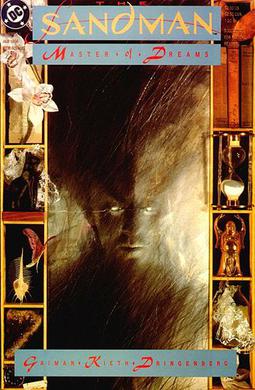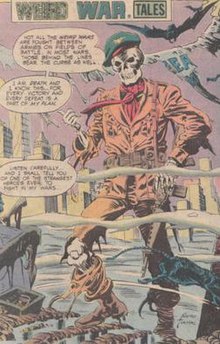
Neil Richard MacKinnon Gaiman ; is an English author of short fiction, novels, comic books, graphic novels, nonfiction, audio theatre, and films. His works include the comic book series The Sandman and novels Stardust, American Gods, Coraline, and The Graveyard Book. He has won numerous awards, including the Hugo, Nebula, and Bram Stoker awards, as well as the Newbery and Carnegie medals. He is the first author to win both the Newbery and the Carnegie medals for the same work, The Graveyard Book (2008). In 2013, The Ocean at the End of the Lane was voted Book of the Year in the British National Book Awards. It was later adapted into a critically acclaimed stage play at the Royal National Theatre in London, England that The Independent called "...theatre at its best".

Preludes & Nocturnes is the first trade paperback collection of the comic book series The Sandman, published by the DC Comics imprint Vertigo. It collects issues #1–8. It is written by Neil Gaiman, illustrated by Sam Kieth, Mike Dringenberg and Malcolm Jones III, colored by Robbie Busch and lettered by Todd Klein.

Season of Mists is a 1990-1991 American eight-part comic and the fourth collection of issues in the DC Comics' The Sandman series. It collects issues #21–28. It was written by Neil Gaiman; illustrated by Kelley Jones, Mike Dringenberg, Malcolm Jones III, Matt Wagner, Dick Giordano, George Pratt, and P. Craig Russell; coloured by Steve Oliff and Daniel Vozzo; and lettered by Todd Klein.

The Sandman is a comic book written by Neil Gaiman and published by DC Comics. Its artists include Sam Kieth, Mike Dringenberg, Jill Thompson, Shawn McManus, Marc Hempel, Bryan Talbot, and Michael Zulli, with lettering by Todd Klein and covers by Dave McKean. The original series ran for 75 issues from January 1989 to March 1996. Beginning with issue No. 47, it was placed under DC's Vertigo imprint, and following Vertigo's retirement in 2020, reprints have been published under DC's Black Label imprint.

Dream of the Endless is a fictional anthropomorphic personification who first appeared in the first issue of The Sandman, written by Neil Gaiman and published by DC Comics. One of the seven Endless, who are inconceivably powerful beings older and greater than gods, Dream is both lord and personification of all dreams and stories, all that is not in reality. He has taken many names, including Morpheus and Oneiros, and his appearance can change depending on the person who is seeing him. Dream was named the sixth-greatest comic book character by Empire Magazine. He was also named fifteenth in IGN's 100 Top Comic Book Heroes list.

Vertigo Comics, also known as DC Vertigo or simply Vertigo, was an imprint of American comic book publisher DC Comics started by editor Karen Berger in 1993. Vertigo's purpose was to publish comics with adult content, such as nudity, drug use, profanity, and graphic violence, that did not fit the restrictions of DC's main line, thus allowing more creative freedom. Its titles consisted of company-owned comics set in the DC Universe, such as The Sandman and Hellblazer, and creator-owned works, such as Preacher, Y: The Last Man and Fables. The Vertigo branding was retired in 2020, and most of its library transitioned to DC Black Label.

Lucifer Samael Morningstar is a character who appears in American comic books published by DC Comics. He is an adaptation of Lucifer—the Biblical fallen angel and devil of Christianity—and is one of the most powerful beings in the DC Universe. Though various versions of the Devil have been presented by DC Comics, this interpretation by Neil Gaiman debuted in The Sandman #4 in 1989. Lucifer appears primarily as a supporting character in The Sandman and as the protagonist of the spin-off Lucifer.

Death: The High Cost of Living is a comic written by Neil Gaiman with art by Chris Bachalo and Mark Buckingham. It is a spin-off from Gaiman's best-selling Vertigo Comics series The Sandman, featuring the Sandman (Dream)'s elder sister, Death of the Endless. Its premise is that Death takes human form once a century, to remain grounded and in touch with humanity, an idea touched upon in several other media, for example in the 1934 film Death Takes a Holiday and in the Terry Pratchett novel Reaper Man.

Titania is a fictional character, a comic book faerie published by DC Comics. She first appeared in The Sandman #19, and was created by Neil Gaiman and Charles Vess. She is inspired by and implied to be the same as Titania as the faerie queen in William Shakespeare's play A Midsummer Night's Dream.

Cain and Abel are a pair of fictional characters in the DC Comics universe based on the biblical Cain and Abel. They are key figures in DC's "Mystery" line of the late 1960s and 1970s, which became the mature-readers imprint, Vertigo, in 1993.

Sandman Mystery Theatre was an ongoing comic book series published by Vertigo Comics, the mature-readers imprint of DC Comics. It ran for 70 issues and 1 annual between 1993 and 1999 and retells the adventures of the Sandman, a vigilante whose main weapon is a gun that fires sleeping gas, originally created by DC in the Golden Age of Comic Books. In a similar vein to Batman, the Sandman possesses no superhuman powers and relies on his detective skills and inventions.

Mike Dringenberg is an American comics artist best known for his work on DC Comics/Vertigo's Sandman series with writer Neil Gaiman.

Michael Zulli is an American artist known for his work as an animal and wildlife illustrator and as a comic book illustrator.

The Dreaming was a monthly comic series that ran for 60 issues and was revived in 2018. It is set in the same dimension of the DC universe as The Sandman and the stories occurred primarily within Dream's realm, The Dreaming, concentrating on characters who had played minor roles in The Sandman, including The Corinthian, Matthew the raven, Cain and Abel, Lucien the dream librarian, the faerie Nuala, Eve, and Mervyn Pumpkinhead. It also introduced a number of new characters, Echo and a new (white) dream raven, Tethys. After those characters were retconned the 2018 version of The Dreaming introduced new characters such as Hyperion Keeter, WAN, and the night hag, Dora. The 2020 spin-off / continuation, The Dreaming: Waking Hours introduced other new characters such as Linsy, Ruin, and most notably, Heather After, a direct descendant of Roderick Burgess. There were brief appearances by The Endless during the series, including cameos by Dream, Death, Destiny, and Desire.

The Little Endless Storybook is a picture book by Jill Thompson published by the Vertigo imprint of DC Comics. It features the popular Endless characters from Neil Gaiman's The Sandman comic book reimagined as toddlers. A second Little Endless Storybook, titled Delirium's Party, was released in 2011.

The Endless are a family of beings who appear in American comic books published by DC Comics. The members of the family include Death, Delirium, Desire, Despair, Destiny, Destruction, and Dream.

The Sandman Universe is a line of American comic books published by DC Comics under its imprints DC Vertigo and DC Black Label. The line launched to celebrate the 30th anniversary of Neil Gaiman's The Sandman (1989–1996) and Vertigo's 25th anniversary. The Sandman Universe began in August 2018, with a titular one-shot, which was followed by four ongoing series—House of Whispers, Lucifer, Books of Magic, and The Dreaming. Each comic is overseen by Gaiman but written by new creative teams.

Black Orchid is an American comic book written by Neil Gaiman with art by Dave McKean. It was published by DC Comics as a three-issue limited series from December 1988 to February 1989, and was later reprinted in trade paperback form. Black Orchid follows two girls, Flora and Suzy, who awaken in a greenhouse. Their journey to find out who they are leads them into contact with DC Universe figures like Batman and Swamp Thing, but also into conflict with criminal mastermind Lex Luthor, who seeks them for his own interests.

The Sandman is an American fantasy drama television series based on the 1989–1996 comic book written by Neil Gaiman and published by DC Comics. The series was developed by Gaiman, David S. Goyer, and Allan Heinberg for the streaming service Netflix and is produced by DC Entertainment and Warner Bros. Television. Like the comic, The Sandman tells the story of Dream/Morpheus, the titular Sandman. The series stars Tom Sturridge as the title character, with Boyd Holbrook, Vivienne Acheampong, and Patton Oswalt in supporting roles.






















